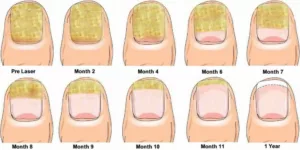Fungal nail infection is a common problem among many. Although not seen potentially dangerous but if remain unchecked, the infected nail can become brittle; foul-smelling and painful. Almost 8 out of 100 people in UK suffer from fungal infection at some point in their lives. But worst is still to come.
About Fungal Nail Treatments
Available Fungal nail infection treatments are often tedious and very lengthy. In most cases, it takes a year of treatment for an infected nail to get detached and phase out and a new healthy one to grow in its place. The chances of such treatments to work are also only 60%-80% only.
So, with slow recovery rates and high potential risk of contamination, in my view what can only be done is to increase awareness. Make yourself aware of the fungal infection causes and try to avoid them
The Causes of Fungal Nail Infections
In this article, after thorough research, we have enlisted the top 5 possible causes of fungal nail infection.
1. Candida Albicans:
Candida Albicans is a form of yeast – a small organism that grows naturally on our body. It just stays there and does nothing.
However, in some rare occasions due to imbalance in yeast and acidophilus (friendly bacteria that keep yeast under control) numbers, yeast may overgrow causing an infection. As our toe nails are when in shoes, dark area with many warm nooks, they provide perfect shelter for yeast. Fungal Nail infection because of Candida may cause pain and swelling or result in the loss of the nail. ZetaClear can help you to get rid of nail fungus. The reviews of ZetaClear have been positive and doctors are recommending it as well. Avoiding nail fungus is the best option, but if you still get it, you can use ZetaClear nail fungus treatment.
2. Dermatophytes:
Athlete’s foot arises in between your toes, with reddening flaky and itchy skin, which can get quite sore. A warm moist atmosphere provides optimum conditions for the yeast to grow faster! That is why probably a third of people with athlete’s foot go on to get a nail infection.
Tinea versicolor is caused by a fungus named Pityrosporum orbiculare, it causes the nail to discolor and leads to a patchy formation that varies in color from white to brown.
3. Overuse of Antibiotics
This is the classic example of science when treating one problem, causes other problems. When we take antibiotic to kill harmful bacteria, we also wipe out friendly bacteria like acidophilus with it. These friendly bacteria are the ones that keep check on fungus and control its growth.
With acidophilus gone, fungus gets a free pass and grows in places it finds suitable. As I said earlier, when in shoes and socks, nails are in the dark, they are warm and cozy, which is ideal for yeast growth
4. Moisture
Fungus loves moisture. Keeping your feet or hands moist and damp for long periods can cause fungus growth. Moisture can come from anywhere For example: If you are a cleaner or a cook, wear protective gloves for long periods, regularly take long swims in swimming pools or wash your hands excessively.
Some of the moisture remains trapped in your finger nails. This encourages fungus to grow.
5. Diabetes and Pregnancy
Yeast/Fungus feast on sugar. High glucose level in your blood stream puts you in danger of getting fungal infections more frequently. If you get three or more fungal infections in a year it is advisable that you ask doctor to test your blood sugar.
Pregnancy causes the immune system to weaken, making you prone to fungal infections.
Further Causes
Other reasons that may cause fungal nail infection is, it may be hereditary, a poor blood supply, (as in the elderly) and a weakened immune system e.g after Chemotherapy of AIDS sufferers
Summary
Just to wrap thing up before I sign off. Obviously prevention is the best treatment. Now you understand the causes and by taking little, ‘do-it-myself’, precautions you can easily keep the infection at bay.
For example: Avoid nail biting; use cotton socks; avoid sharing shoes; stop frequent use of artificial nails and above all, keep your nails clean dry, cut and short. These easy-to-do daily tips can help to keep nail fungus infections at bay








